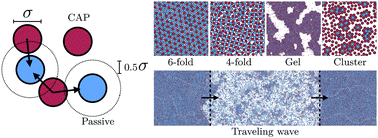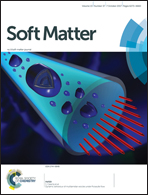Tunable emergent structures and traveling waves in mixtures of passive and contact-triggered-active particles†
Abstract
We investigate emergent behavior in binary mixtures comprised of passive particles and contact-triggered active particles (CAPs), where a propulsion force is applied on CAPs towards passive particles when the two are in contact. We show that such mixtures phase separate into distinct dense and dilute phases with as few as 10% CAPs. Furthermore, the structure of the dense phase can be tuned by varying the fraction of CAPs and the strength of their propulsion force. The dense phase is classified into seven structure types, which includes both 6-fold and 4-fold ordered crystals, and kinetically arrested gels and clusters. Mixtures with fewer than 35% CAPs exhibit traveling density waves such that one end of the dense phase recedes while the other propagates. This phenomenon results from the spontaneous symmetry breaking of particle flux at the dense–dilute interface. We show that contact-triggered activity can be employed to develop materials with a wide range of structures and dynamics.



 Please wait while we load your content...
Please wait while we load your content...